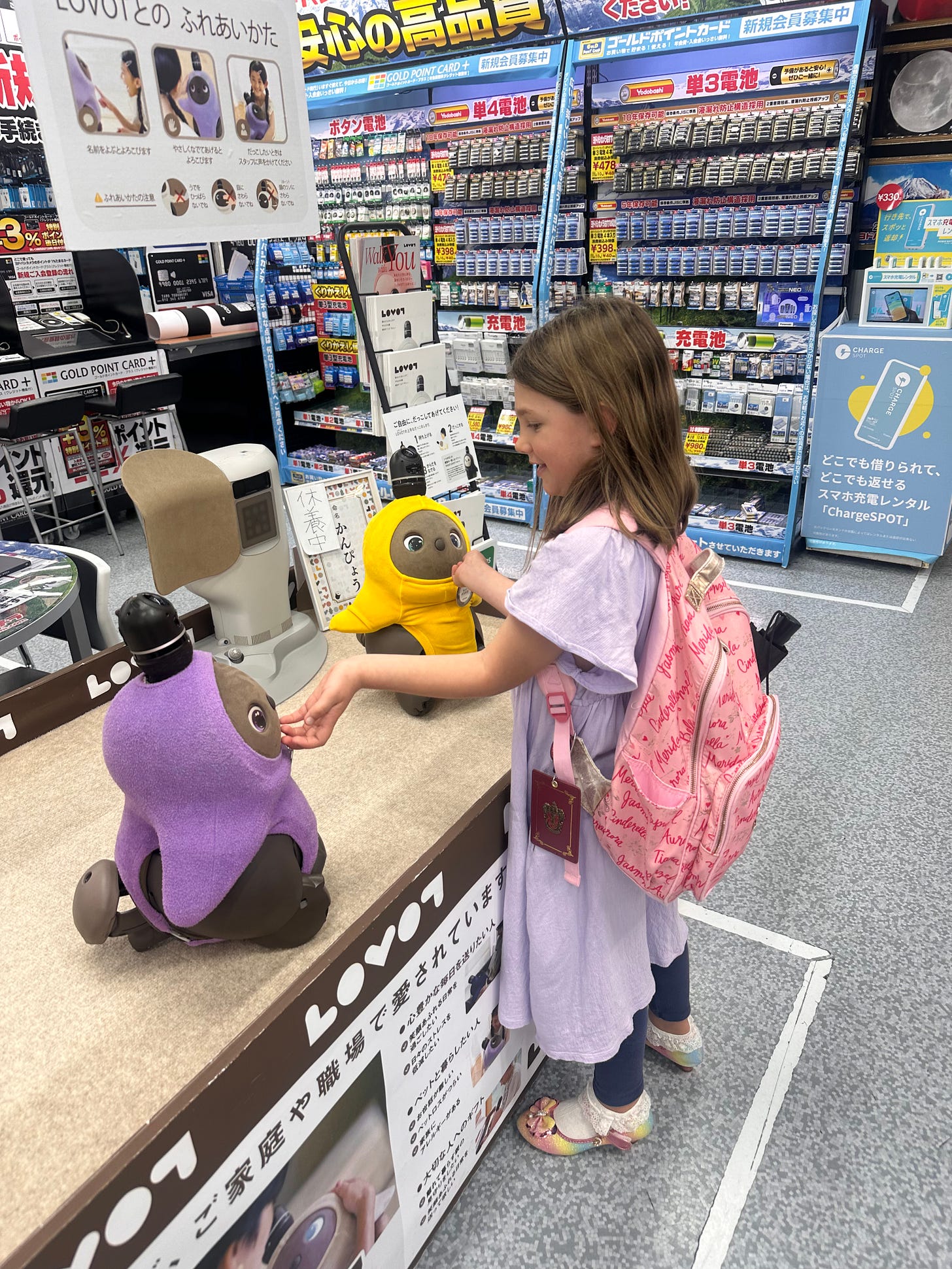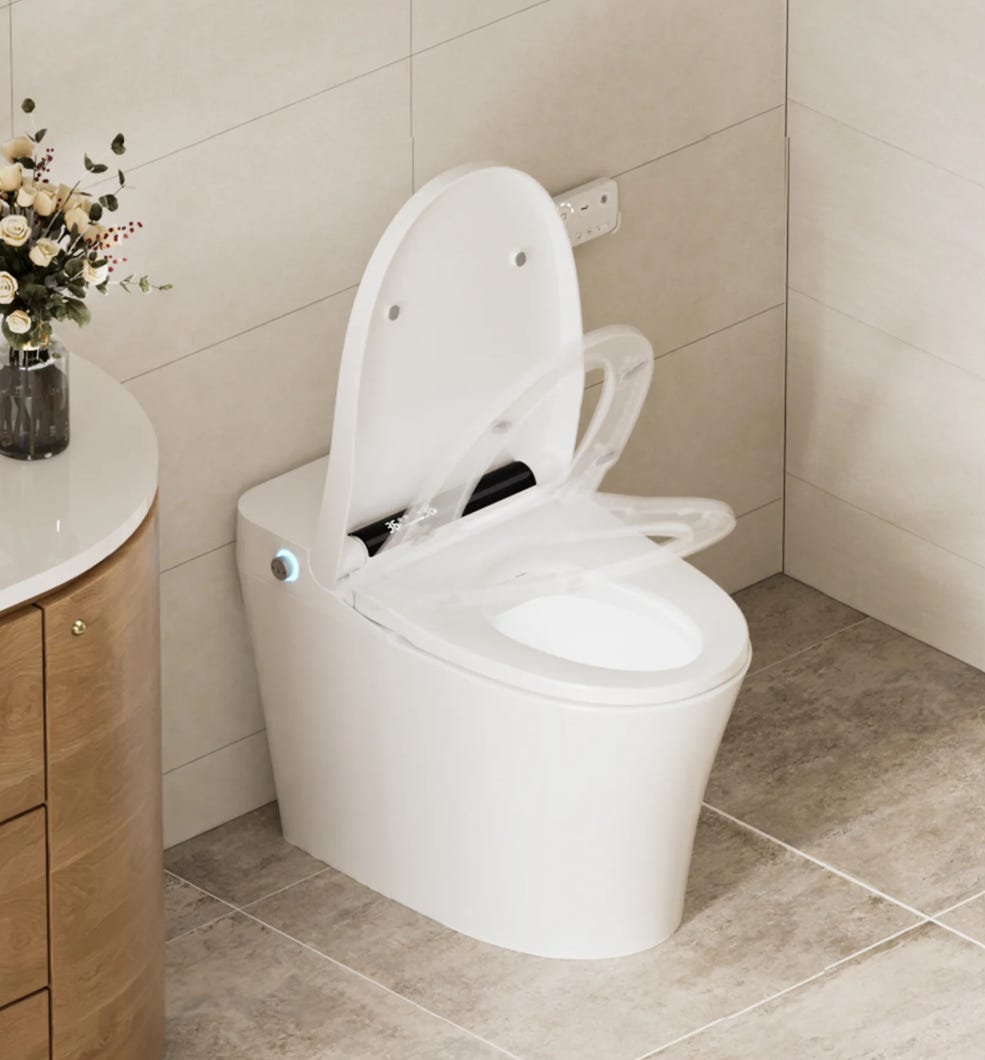Technological Paradise Lost
I intend to quash the misconception here and now that Japan is some sort of futuristic technological paradise. It’s not.
A friend sent me a video on social media where sprinklers popped up from a snowy road to spray deicer. The caption read, “Japan really is over here living in the future.” To my frustration, I regularly come across social media posts evangelizing that Japan is the future and the rest of us are just living in the past. However, this utopian façade ignores the reality of life in Japan.
Admittedly, there is some entertaining technology here. Did you know there are hotels in Tokyo where incredibly lifelike robots act as receptionists? In some cases, those receptionists are raptors that look like they came straight out of Jurassic Park. Maybe others did not watch the movie at a tender age, but why anyone would want to be terrified while collecting their room key is beyond me.
A few weeks ago, Franny played with interactive robot pets fully equipped with a camera on their heads at an electronic store. I’ve had miniature trains deliver sushi to my table and robots roll around with trays to collect the empty dishes. In terms of technology that is [clears throat] actually useful, I find the most beneficial innovation to be the shinkansen, also known as the bullet train. These high-speed trains were invented in 1964 and travel up to 200 mph. They are a fast and convenient way to move around Japan.[1]
Most of Japan does not look like a high-tech dreamland – it looks like the 1990s. Japan was in an economic boom that started around 1955 and continued until the 1980s.[2] However, the bubble burst around 1990 resulting in stagnation and deflation. The following economic crisis became known as “The Lost Decade.” Even now the yen has not completely recovered. In late 2024, the yen plummeted again to its lowest level compared to the dollar since the 1990s. Based on observation, many buildings and infrastructure were built during the economic boom and are in noticeable need of renovation.
That is not to say Japan is completely void of new builds. Younger people are moving from the rural areas and smaller metropolises into the larger cities resulting in more construction and expansion in those locations. Particularly in Tokyo, there are structures and areas with a creative modern aesthetic. As an aside, a glance at the Tokyo skyline makes me wish I had invested in construction cranes in the early 2000s. Imagine it, large red “Clum Cranes” all over Tokyo. Shoulda, coulda, woulda…
Development in the largest cities aside, in some ways Japan feels like it is living in the past – not the future. For example, the culture is still utterly reliant on paper. Daily, Franny’s school sends home paper notices.[3] Government offices still do much of their business and communication in paper. I have filled up six large three ring binders with “important” documents from the schools and government in the year and half that we have been living in Japan. Related to their love of paper, numerous businesses still rely on fax machines. To that end, too frequently Japanese websites look like they were designed while the creator was listening to a newly released Nirvana CD.
It is not just paper in the workplace; Japan is also still heavily reliant on paper money. Until recently, Japan was largely a cash-based society. It was only because Japan hosted the Olympics in 2021 that their government encouraged businesses to start accepting credit cards and other cashless payments. However, it is still necessary to carry cash as cash-only establishments are common.
If Japan is a technological paradise, why doesn’t my washing machine get my clothes clean? And do not blame the fact that it is an old rental. It was built in 2023 and was brand new when we received it! Regardless of how much laundry soap and stain remover I use; my clothes are never completely clean. Furthermore, the clothes have to then hang dry all day because the dryer function on the washer/dryer combo takes at least three hours and still leaves clothes feeling damp.
If Japanese technology is so futuristic, why does the main electrical breaker in our house blow every time we simultaneously use the microwave, stove, and coffee maker while cooking breakfast? Why is my dishwasher the size of a bread box? Why don’t I have a garbage disposal? Why can’t I find a mop that does not break after a month?
It is not just domestic appliances that are stuck in a time warp; the culture seems reluctant to adopt anything that would make women’s lives easier. Groceries cannot be ordered online.[4] Babysitters are not a thing. At least not hourly babysitters like we have in the US so parents can have a night off. Hiring cleaning people to help with housework is such a rare practice that it is cost prohibitive.
If you know me at all, you know I have a theory as to why Japan does not innovate in ways that would make shufu’s[5] lives more efficient. While many of the buildings and infrastructure feel like the 1990s, the mentality around gender equality feels more like the 1960s.[6] From that perspective, there is no need to invest in making domestic life easier when women are still expected to dedicate much of their existence to their home and children.
The World Economic Fund measures parity between the sexes each year in their Global Gender Gap Report. [7] On a scale of 0 to 1, with 1 being complete gender parity, in the 2024 report the top ranked Iceland scored a .935, while Japan scored a depressing .663. For context, the United States scored .747.
Where Japan’s ranking is truly shocking and unacceptable is in the realms of economic and political power for women. Looking at the metric of economic opportunity and participation, Japan is ranked 120th out of 146 countries. It is just above countries like Lebanon, Qatar, and Saudi Arabia where women do not have equal rights. The United States is ranked 22nd. Japan is sandwiched between Pakistan and Turkey at the 113th place for women’s political empowerment. The US is ranked 63rd. Overall, Japan’s Global Gender Gap Index is 118th out of 146 countries while the US is 43rd. [8]
The inexcusable lack of economic and political power is why I believe Japan does not invest enough in technologies to make domestic life, i.e. women’s lives, better.[9] As a rule, I refuse to call any country a futuristic utopia when it does not have complete parity between the sexes on all metrics. I’m scowling at you, United States. This is also why I get frustrated whenever a well-meaning friend annoyed by politics in the US says, “you should just stay in Japan.”
Japan is not a paradise – political, technological, or otherwise. As of yet, no society is, which proves John Milton’s point when he wrote, “Solitude sometimes is best society.”
There is one area where I am willing to grant Japan the technology trophy. That is in the area of toilets. I have written about Japanese bathrooms in the past, but they deserve further mentioning. The top-of-the-line toilet models have motion censored lids that open and close as you approach and walk away. The toilets flush automatically, and the really nice ones play the sound of running water when you sit down. The bathroom stalls go floor to ceiling and are usually supplied with disinfectant for the toilet seat. Some toilets even spray cleaner automatically into the bowl between uses. Most Japanese toilets have a bidet setting that allows the user to adjust the direction and intensity of the spray. Hours could be spent just giving your ass a spa day. Some of these fancy toilets sell for as much as $3,000. That said, I found one online that was an “Expert Pick” toilet selling for over $23,000. I shit you not, pun intended.
Japanese privies aside, you now have my reasons for believing that Japan is a technological paradise lost. Just think of me as the serpent disillusioning readers. As Milton wrote, “Better to reign in Hell, than to serve in Heaven,” which really has nothing to do with nothing. But I wanted to end with a fabulous Milton quote.
[1] Bullet train tickets are more expensive than social media led me to believe but definitely more convenient than flying.
[2] Please note, the shinkansen was invented during this time.
[3] They also send daily messages through the app. It really is too much.
[4] At least not in Utsunomiya.
[5] Japanese for housewife.
[6] On a related note, married Japanese women are still legally required to take their husband’s last name.
[7] https://www.weforum.org/publications/global-gender-gap-report-2024/in-full/
[8] Just for fun, the top three ranked countries in order are Iceland, Finland, and Norway. The bottom three countries in order are Chad, Pakistan, and Sudan.
[9] Side note, while it is ranked below the US, Japan is close to parity among the sexes in terms of education attainment with a score of .993. Meaning Japanese women are attending and graduating from higher education at almost the same rate as their male colleagues. As evidenced by their lack of economic and political power, we know that at some point Japanese women become either underemployed or absent from the workforce altogether. This is possibly (probably) because part-time work or unemployment is necessary to sustain the culturally demanding home life.







“Progress toward gender equality has been slow in Japan, where women are far outnumbered at the highest levels of business and government and bear a disproportionate responsibility for child care and household chores.” https://www.nbcnews.com/world/asia/sanae-takaichi-becomes-japans-first-female-prime-minister-rcna238601
I said it first.